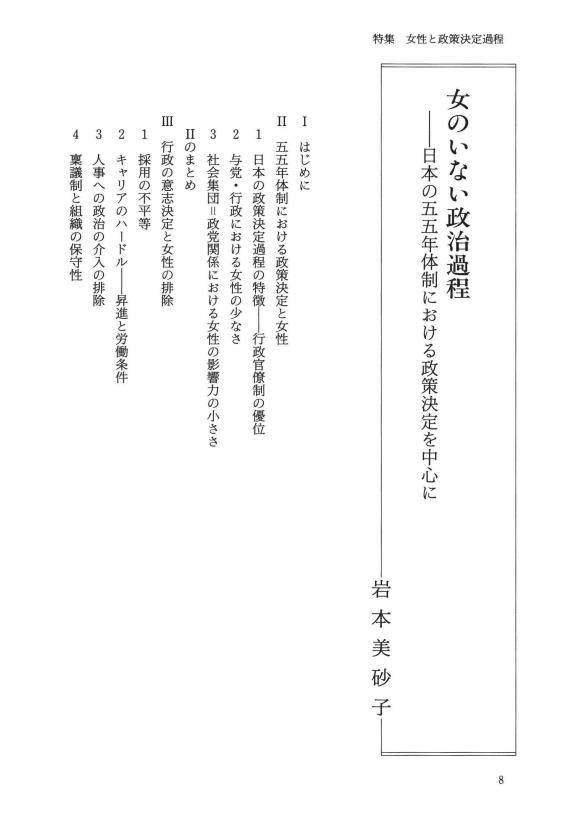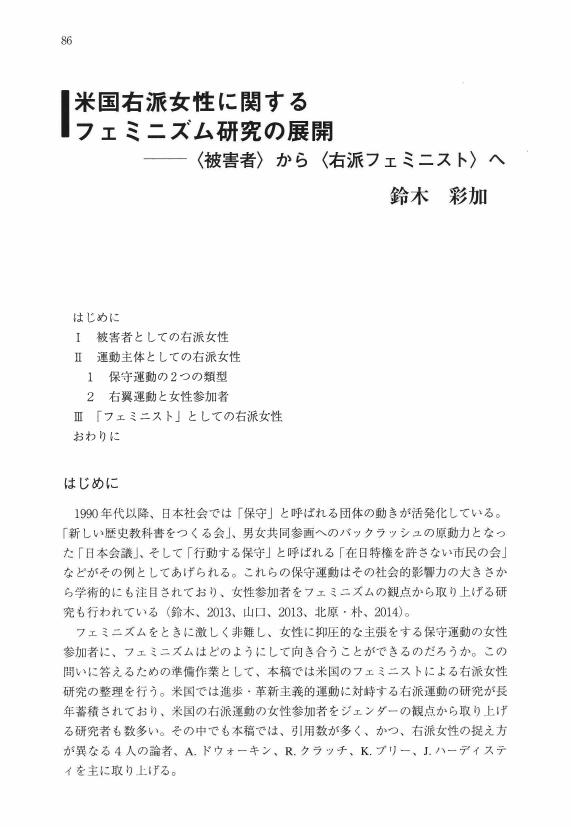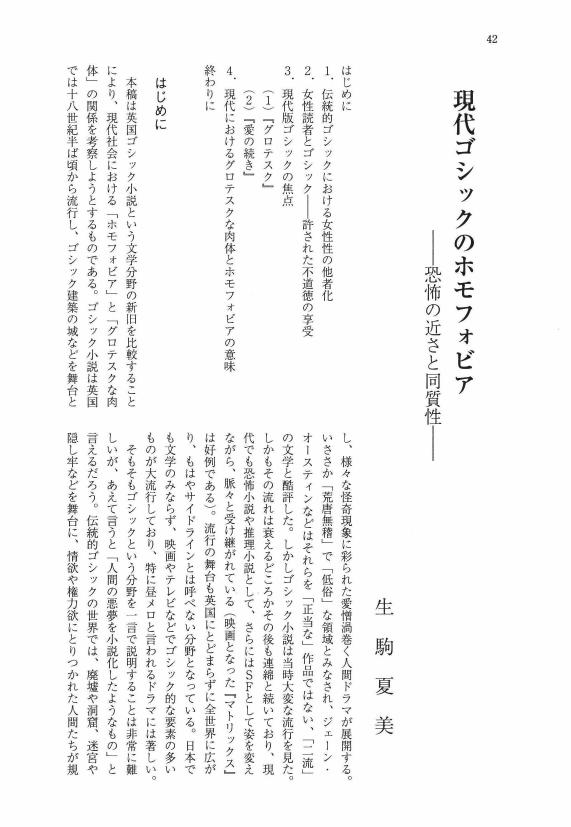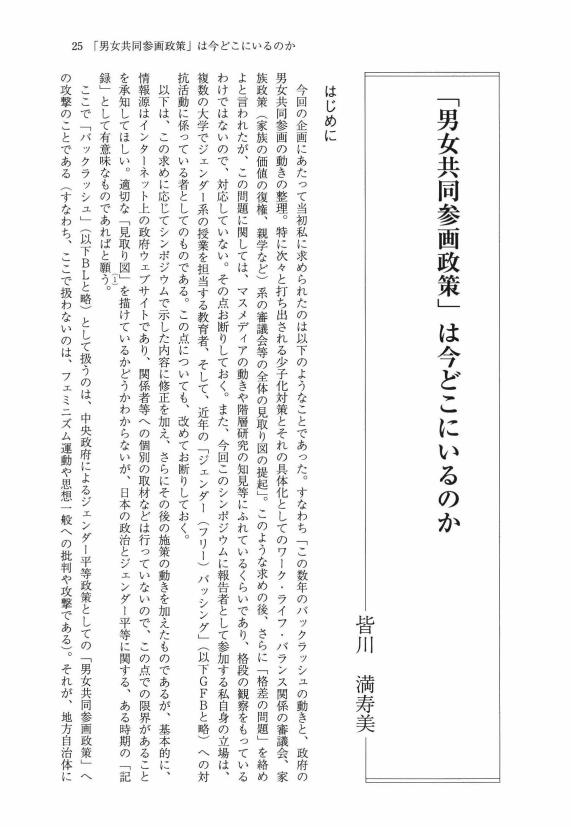- 著者
- 二階堂 祐子
- 出版者
- 日本女性学会
- 雑誌
- 女性学 (ISSN:1343697X)
- 巻号頁・発行日
- vol.19, pp.89-107, 2012-03-31 (Released:2021-11-25)
30 0 0 0 OA 日本の中絶の安全性は確認されたのか ―日本産婦人科医会の医師らによる中絶実態調査報告の見直し
- 著者
- 塚原 久美
- 出版者
- 日本女性学会
- 雑誌
- 女性学 (ISSN:1343697X)
- 巻号頁・発行日
- vol.28, pp.79-100, 2021-03-31 (Released:2022-04-01)
- 参考文献数
- 32
Two different surveys have revealed that the surgical abortion method called dilatation and curettage (D&C) is the method of choice for many Japanese OB-GYN doctors for early-term abortions: less than 12 weeks into the pregnancy. The doctors who conducted the second research admit that D&C has a significantly higher rate of complications than the aspiration method. However, they conclude that “there are no major problems with the safety of abortion care in Japan.” This paper considers why the doctors have reached such a conclusion and whether this conclusion is valid. As a result of detailed examinations of the doctors’ report, we have found that the selection of the comparison data, the method of comparison, and the method of citation are inappropriate and unusual. They conclude based on their arbitrarily selected data, which could hardly be called rational. Although there are mistakes that could be mere carelessness or coincidence, we suspect that the authors are intentional because everything has been manipulated to make us believe that “abortion in Japan is safe.” Moreover, we have analyzed their request for cooperation in the questionnaire survey to find their strong intentions to prove the safety of abortion in Japan. Furthermore, the study concludes that the aspiration method is safer than D&C but contradictorily states that there is no major problem with the safety of abortion in Japan. Therefore their purpose of the study is to conclude that abortion in Japan is safe. Thus, it seems highly likely that the reporters have been influenced by the common interests of the medical association members. Their conclusions of the report are questionable, and there is little evidence to support the continued acceptance of the use of D&C.
26 0 0 0 OA 「男性性による抑圧」と「男性性からの解放」で終わらない男性性研究へ
- 著者
- 平山 亮
- 出版者
- 日本女性学会
- 雑誌
- 女性学 (ISSN:1343697X)
- 巻号頁・発行日
- vol.27, pp.42-56, 2020-04-15 (Released:2021-10-22)
- 参考文献数
- 18
This article proposes that masculinity scholars direct more considerable attention to when and how diverse notions of what men are like (i.e., masculinities) are utilized to stabilize and reproduce unequal gender relations. In doing so, I argue that the conceptual framework of hegemonic masculinity helps us to analyze how multiple masculinities are discursively organized and mobilized to cultivate and reinforce people's tolerant attitudes toward structural male supremacy. Although hegemonic masculinity has been typically understood/misunderstood as the most powerful, celebrated form of masculinity in a societal setting, which Messerschmidt (2016) termed as dominant masculinity, what characterizes hegemonic masculinity is its function for unequal gender relations; that is, a particular notion of what men are like can be described as hegemonic masculinity when it helps to legitimize men's privilege. Referring to the prevailing view of men as inhibited from engaging in family caregiving by the long-hour work culture in Japan, I discuss how such a view can function as hegemonic masculinity that makes people hesitant to openly criticizing men's little involvement with personal care work. This article also discusses how the framework of hegemonic masculinity helps masculinity scholars to reflect on their work such that they will not become inadvertently implicated in legitimizing unequal gender relations.
21 0 0 0 OA 期待を裏切る ―フェムとその不可視の「アイデンティティ」について―
- 著者
- 清水 晶子
- 出版者
- 日本女性学会
- 雑誌
- 女性学 (ISSN:1343697X)
- 巻号頁・発行日
- vol.11, pp.52-68, 2004-04-15 (Released:2021-12-17)
18 0 0 0 OA 「男はつらいよ型男性学」の限界と可能性 ―ポジショナリティ論とグローバリゼーションとの関わりで―
- 著者
- 江原 由美子
- 出版者
- 日本女性学会
- 雑誌
- 女性学 (ISSN:1343697X)
- 巻号頁・発行日
- vol.27, pp.10-22, 2020-04-15 (Released:2021-10-22)
- 参考文献数
- 15
The purpose of this paper is to explore both the problems and possibilities of men's studies from the perspective of gender equality. The recent discussions in men's studies are apt to focus on the harshness of men's burden and their multiple responsibilities, which this paper names “Otoko ha Trurai-yo Gata Danseigaku (men's studies based on the discourse of the burden of men's multiple responsibilities).” Indeed this approach to men's studies recently has played a vital role in social education and employee education and helps middle-aged men have a new perspective into gender issues. However, there are also many criticisms that this approach hinders the realization of gender equality. This paper surveys the points of discussion using the theory of positionality and presents the limitations of “Otoko ha Trurai-yo Gata Danseigaku.” This paper analyses that the male sense of burden is the result of globalism and that it is likely to cause conservative attitudes and minority exclusion. It is necessary to propose an alternative direction of men's studies for gender equality and men's liberation
17 0 0 0 OA 女性学にとってのミードとマネー
- 著者
- 井上 輝子
- 出版者
- 日本女性学会
- 雑誌
- 女性学 (ISSN:1343697X)
- 巻号頁・発行日
- vol.13, pp.148-155, 2006-03-31 (Released:2021-12-09)
- 著者
- 岩本 美砂子
- 出版者
- 日本女性学会
- 雑誌
- 女性学 (ISSN:1343697X)
- 巻号頁・発行日
- no.5, pp.8-39, 1997
13 0 0 0 OA 女のいない政治過程 ―日本の五五年体制における政策決定を中心に
- 著者
- 岩本 美砂子
- 出版者
- 日本女性学会
- 雑誌
- 女性学 (ISSN:1343697X)
- 巻号頁・発行日
- vol.5, pp.8-39, 1997-12-10 (Released:2022-01-17)
13 0 0 0 OA 米国右派女性に関するフェミニズム研究の展開 ―〈被害者〉から〈右派フェミニスト〉へ
- 著者
- 鈴木 彩加
- 出版者
- 日本女性学会
- 雑誌
- 女性学 (ISSN:1343697X)
- 巻号頁・発行日
- vol.22, pp.86-92, 2015-03-31 (Released:2021-11-12)
- 著者
- 遠山 日出也
- 出版者
- 日本女性学会
- 雑誌
- 女性学 (ISSN:1343697X)
- 巻号頁・発行日
- vol.29, pp.150-155, 2022-03-31 (Released:2023-04-01)
8 0 0 0 OA 運動部活動におけるミソジニスティック/ホモフォビックな会話と性差別意識
- 著者
- 三上 純
- 出版者
- 日本女性学会
- 雑誌
- 女性学 (ISSN:1343697X)
- 巻号頁・発行日
- vol.29, pp.76-104, 2022-03-31 (Released:2023-04-01)
- 参考文献数
- 19
本稿の目的は、グループ・インタビューとアンケート調査の分析を通じて、運動部活動におけるミソジニスティック/ホモフォビックな会話の実態と、それが性差別意識といかに関連しているのかを明らかにすることである。 グループ・インタビューでは、男性のみの運動部集団において女性を性的客体とみなすミソジスティックな会話と、同性愛をタブー視するホモフォビックな会話があったことが語られた。アンケート調査の分析では、女性を性的客体、男性を性的主体とする意識と、ゲイに対する態度を従属変数とする重回帰分析を行った。その結果、性的マジョリティ男性は非対称な性的関係を肯定する傾向がみられたが、それは運動部活動におけるミソジニスティック/ホモフォビックな会話に媒介されたものであることが明らかになった。しかし、ゲイに対する態度についてはそうした会話に十分な媒介効果がみられなかった。なお、いずれの従属変数についても男女が生まれつき異なる存在であるとする考え方が強く関連していることが明らかとなった。 本稿の分析から、性差別を助長すると考えられる運動部活動におけるミソジニーやホモフォビアに対処するためには、生物学的な男女の差異を自然とみなす状況を問い直すことが必要であると考えられる。
- 著者
- 鶴田 幸恵
- 出版者
- 日本女性学会
- 雑誌
- 女性学 (ISSN:1343697X)
- 巻号頁・発行日
- vol.16, pp.85-100, 2008
7 0 0 0 OA 夫婦別姓と戸籍制度改革―その方向性
- 著者
- 大村 芳昭
- 出版者
- 日本女性学会
- 雑誌
- 女性学 (ISSN:1343697X)
- 巻号頁・発行日
- vol.3, pp.47-59, 1995-11-30 (Released:2022-01-17)
7 0 0 0 OA 現代ゴシックのホモフォビア ―恐怖の近さと同質性―
- 著者
- 生駒 夏美
- 出版者
- 日本女性学会
- 雑誌
- 女性学 (ISSN:1343697X)
- 巻号頁・発行日
- vol.13, pp.42-58, 2006-03-31 (Released:2021-12-09)
6 0 0 0 OA 仕組まれた「水子信仰」のルーツと展開 ―「男制」の思想と社会の形成(下)―
- 著者
- 溝口 明代
- 出版者
- 日本女性学会
- 雑誌
- 女性学 (ISSN:1343697X)
- 巻号頁・発行日
- vol.4, pp.180-206, 1996-12-10 (Released:2022-01-17)
5 0 0 0 OA アメリカ女性運動/フェミニズムの歴史再考 ―多文化主義とトランスナショナリズム
- 著者
- 有賀 夏紀
- 出版者
- 日本女性学会
- 雑誌
- 女性学 (ISSN:1343697X)
- 巻号頁・発行日
- vol.28, pp.126-139, 2021-03-31 (Released:2022-04-01)
- 著者
- 石井 由香理
- 出版者
- 日本女性学会
- 雑誌
- 女性学 : 日本女性学会学会誌 (ISSN:1343697X)
- 巻号頁・発行日
- vol.19, pp.56-72, 2011
5 0 0 0 OA 日本の雑誌記事が描く日本人配偶者を持つ在日中国人女性 ─1990〜2000年代を中心に─
- 著者
- 鄧 婉瑩
- 出版者
- 日本女性学会
- 雑誌
- 女性学 (ISSN:1343697X)
- 巻号頁・発行日
- vol.27, pp.58-79, 2020-04-15 (Released:2021-10-22)
- 参考文献数
- 25
The purpose of this paper is to describe images of Chinese women with Japanese spouses in Japanese magazine articles during the 1990s and 2000s. In magazine articles from the 1990s, when international marriages between Chinese women and Japanese men were increasing, Chinese women were portrayed as “brides of the farmhouse” who could be purchased like products by Japanese men with economic power. The increase of international marriages between Chinese women and Japanese men has the background of a “shortage of brides” in rural Japan. They were regarded as alternatives to Japanese women who could support the patriarchal family system and fulfill the gender roles of “wife” and “mother.” However, in the 2000s, as Japan’s immigration control policies became stricter, Chinese women, who were supposed to become spouses of Japanese men, deviated from the gender norms and came to be seen as criminals that were a huge threat to “Japanese people” and “Japanese society,” as reported in the magazine articles. In this way, the images of Chinese women with Japanese spouses in magazine articles have primally changed from “good wives” who were subordinate to Japanese men sexually and performed their gender roles well, into that of criminals. This shift can be linked to the context where the Japanese government strengthened its control over illegal employment, “illegal residents,” and fake marriage cases involving foreigners in Japan.
- 著者
- 野田 恵子
- 出版者
- 日本女性学会
- 雑誌
- 女性学 (ISSN:1343697X)
- 巻号頁・発行日
- vol.13, pp.59-75, 2005
4 0 0 0 OA 「男女共同参画政策」は今どこにいるのか
- 著者
- 皆川 満寿美
- 出版者
- 日本女性学会
- 雑誌
- 女性学 (ISSN:1343697X)
- 巻号頁・発行日
- vol.16, pp.25-39, 2009-03-31 (Released:2021-12-05)









